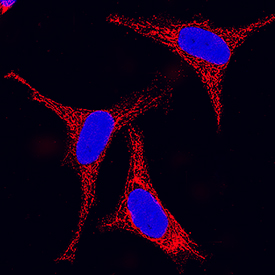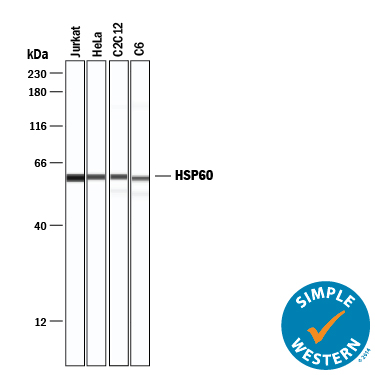Human/Mouse/Rat HSP60 Antibody Summary
Met1-Phe573
Accession # P10809
Applications
Please Note: Optimal dilutions should be determined by each laboratory for each application. General Protocols are available in the Technical Information section on our website.
Scientific Data
 View Larger
View Larger
Detection of Human/Mouse/Rat HSP60 by Western Blot. Western blot shows lysates of MCF-7 human breast cancer cell line, DA3 mouse myeloma cell line, and Nb2-11 rat lymphoma cell line. PVDF membrane was probed with 0.5 µg/mL of Mouse Anti-Human/Mouse/Rat HSP60 Monoclonal Antibody (Catalog # MAB1800) followed by HRP-conjugated Anti-Mouse IgG Secondary Antibody (Catalog # HAF007). A specific band was detected for HSP60 at approximately 62 kDa (as indicated). This experiment was conducted under reducing conditions and using Immunoblot Buffer Group 2.
 View Larger
View Larger
HSP60 in HeLa Human Cell Line. HSP60 was detected in immersion fixed HeLa human cervical epithelial carcinoma cell line using Mouse Anti-Human/Mouse/Rat HSP60 Monoclonal Antibody (Catalog # MAB1800) at 25 µg/mL for 3 hours at room temperature. Cells were stained using the NorthernLights™ 557-conjugated Anti-Mouse IgG Secondary Antibody (red; Catalog # NL007) and counterstained with DAPI (blue). Specific staining was localized to cytoplasm. View our protocol for Fluorescent ICC Staining of Cells on Coverslips.
 View Larger
View Larger
Detection of Human, Mouse, and Rat HSP60 by Simple WesternTM. Simple Western lane view shows lysates of Jurkat human acute T cell leukemia cell line, HeLa human cervical epithelial carcinoma cell line, C2C12 mouse myoblast cell line, and C6 rat glioma cell line, loaded at 0.2 mg/mL. A specific band was detected for HSP60 at approximately 60 kDa (as indicated) using 1 µg/mL of Mouse Anti-Human/Mouse/Rat HSP60 Monoclonal Antibody (Catalog # MAB1800). This experiment was conducted under reducing conditions and using the 12-230 kDa separation system.
Reconstitution Calculator
Preparation and Storage
- 12 months from date of receipt, -20 to -70 °C as supplied.
- 1 month, 2 to 8 °C under sterile conditions after reconstitution.
- 6 months, -20 to -70 °C under sterile conditions after reconstitution.
Background: HSP60
Heat shock proteins (HSPs) are a family of highly conserved stress response proteins. Heat shock proteins function primarily as molecular chaperones by facilitating the folding of other cellular proteins, preventing protein aggregation or targeting improperly folded proteins to specific degradative pathways. HSPs are typically expressed at low levels under normal physiological conditions but are dramatically upregulated in response to cellular stress. Heat Shock Protein 60 (HSP60), also known as Chaperonin 60 (CPN60), is a mitochondrial matrix protein belonging to a highly conserved family of molecular chaperone and stress response proteins. HSP60 plays a role in stabilizing and refolding proteins in response to heat-shock or other cellular stress. Full length human HSP60 is 98% identical to mouse and rat HSP60.
Product Datasheets
Citations for Human/Mouse/Rat HSP60 Antibody
R&D Systems personnel manually curate a database that contains references using R&D Systems products. The data collected includes not only links to publications in PubMed, but also provides information about sample types, species, and experimental conditions.
6
Citations: Showing 1 - 6
Filter your results:
Filter by:
-
Kinetic modeling of H2O2 dynamics in the mitochondria of HeLa cells
Authors: KT Stein, SJ Moon, AN Nguyen, HD Sikes
PLoS Comput. Biol., 2020-09-14;16(9):e1008202.
Species: Human
Sample Types: Whole Cells
Applications: Western Blot -
C9ORF72-ALS/FTD-associated poly(GR) binds Atp5a1 and compromises mitochondrial function in vivo
Authors: SY Choi, R Lopez-Gonz, G Krishnan, HL Phillips, AN Li, WW Seeley, WD Yao, S Almeida, FB Gao
Nat. Neurosci., 2019-05-13;0(0):.
Species: Mouse
Sample Types: Whole Tissue
Applications: IHC-Fr -
MICU1 Confers Protection from MCU-Dependent Manganese Toxicity
Authors: J Wettmarsha, V Goh, KT Huang, DM Arduino, U Tripathi, A Leimpek, Y Cheng, AA Pittis, T Gabaldón, D Mokranjac, G Hajnóczky, F Perocchi
Cell Rep, 2018-11-06;25(6):1425-1435.e7.
Species: Human
Sample Types: Cell Lysates
Applications: Western Blot -
Comparative analysis of the interaction of HSPs in dendritic cells, macrophages, RGM-1 cells infected by Helicobacter pylori
Authors: Guangxin Li
Am J Transl Res, 2016-10-15;8(10):4184-4194.
Species: Rat
Sample Types: Whole Cells
Applications: Western Blot -
Heat shock protein 60: an endogenous inducer of dopaminergic cell death in Parkinson disease.
Authors: Noelker C, Morel L, Osterloh A, Alvarez-Fischer D, Lescot T, Breloer M, Gold M, Oertel W, Henze C, Michel P, Dodel R, Lu L, Hirsch E, Hunot S, Hartmann A
J Neuroinflammation, 2014-05-08;11(0):86.
Species: Human
Sample Types: Cell Lysates
Applications: Western Blot -
Nitric oxide-induced apoptosis in RAW 264.7 macrophages is mediated by endoplasmic reticulum stress pathway involving ATF6 and CHOP.
Authors: Gotoh T, Oyadomari S, Mori K, Mori M
J. Biol. Chem., 2002-01-22;277(14):12343-50.
Species: Human
Sample Types: Cell Lysates
Applications: Western Blot
FAQs
No product specific FAQs exist for this product, however you may
View all Antibody FAQsReviews for Human/Mouse/Rat HSP60 Antibody
There are currently no reviews for this product. Be the first to review Human/Mouse/Rat HSP60 Antibody and earn rewards!
Have you used Human/Mouse/Rat HSP60 Antibody?
Submit a review and receive an Amazon gift card.
$25/€18/£15/$25CAN/¥75 Yuan/¥2500 Yen for a review with an image
$10/€7/£6/$10 CAD/¥70 Yuan/¥1110 Yen for a review without an image

